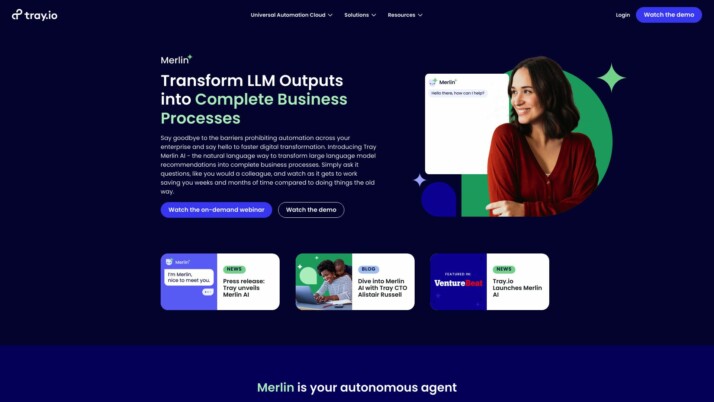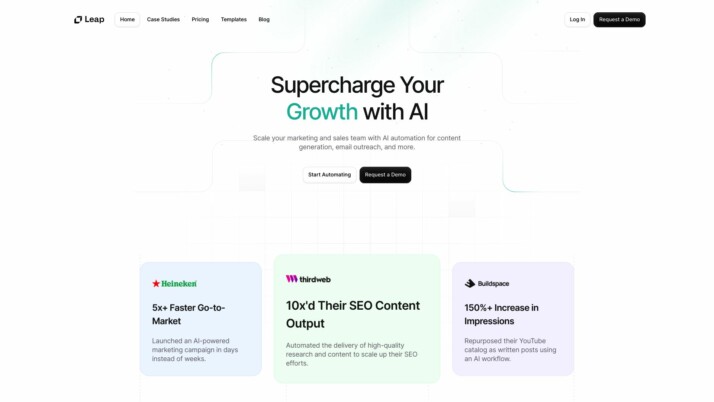Tray Merlin AI vs. Leap AI: Comparing AI Workflow Automation Platforms
AI-powered workflow automation transforms business operations, but choosing the right platform can be challenging. This comparison explores Tray Merlin AI’s natural language-driven process creation and Leap AI’s versatile no-code application builder, alongside our own SmythOS. We examine each platform’s approach to AI integration, ease of use, security features, and scalability. Whether you’re a developer seeking powerful customization, a business leader focused on enterprise-grade solutions, or a non-technical user looking for accessible AI tools, this analysis will help you navigate the landscape of AI workflow automation platforms and make an informed decision for your organization’s needs.
Tray Merlin AI Overview
Tray Merlin AI revolutionizes business process automation by transforming language model outputs into actionable workflows. This AI-powered platform enables users to create complex automations through natural language instructions, bridging the gap between human intent and machine execution.
Merlin serves as an autonomous agent, interpreting user requests and translating them into fully functional business processes. The platform’s low-code visual builder empowers both technical and non-technical users to construct sophisticated workflows without extensive programming knowledge. This democratization of automation accelerates digital transformation initiatives across organizations.


Tray Merlin AI revolutionizes business process automation by transforming language model outputs into actionable workflows.
Unlike many AI solutions, Tray Merlin AI prioritizes data security by processing information within its closed ecosystem. This approach prevents exposure of sensitive data to external language models, addressing a critical concern for enterprises handling confidential information. The platform’s extensive library of pre-built connectors facilitates seamless integration with over 600 popular business applications, streamlining workflow creation across diverse systems.
Tray Merlin AI’s scalability and robust security measures position it as a viable solution for enterprises seeking to implement AI-driven automation at scale. The platform’s governance features and authentication protocols ensure that automated processes adhere to organizational policies and compliance requirements. However, the reliance on predefined connectors may limit flexibility for highly customized integrations in some scenarios.
While Tray Merlin AI excels in transforming natural language inputs into functional workflows, it lacks some advanced AI capabilities such as multimodal processing and a hosted vector database. These limitations may impact its suitability for certain specialized use cases that require handling diverse data types or performing complex AI operations beyond workflow automation.
Leap AI Overview
Leap AI empowers users to create sophisticated AI workflows without coding expertise. The platform’s no-code visual interface allows rapid development of AI-powered applications, from chatbots to content generators. Leap AI integrates with popular AI models like OpenAI GPT and Stable Diffusion XL, offering versatility across text, image, and audio generation tasks.
The platform shines in its accessibility, providing drag-and-drop tools and an extensive template library. This approach democratizes AI development, enabling both technical and non-technical users to harness advanced AI capabilities. Leap AI’s SDK support (RESTful API, TypeScript, Python) facilitates seamless integration into existing systems, appealing to developers seeking customization options.


Leap AI empowers users to create sophisticated AI workflows without coding expertise. The platform’s no-code visual interface allows rapid development of AI-powered applications, from chatbots to content generators.
Leap AI stands out with its AI model training features, allowing users to fine-tune models on proprietary datasets. This capability enhances the specificity and accuracy of AI outputs, crucial for businesses requiring tailored solutions. The platform’s integration ecosystem, connecting with tools like Slack, Hubspot, and Zapier, positions it as a versatile choice for workflow automation and AI-driven process enhancement.
While Leap AI offers robust features for AI workflow creation, it may face challenges in areas like advanced debugging tools and explainability features. The platform’s focus on accessibility could potentially limit some advanced customization options that experienced developers might seek. Additionally, the reliance on third-party AI models may introduce dependencies that could affect long-term stability or performance.
Leap AI’s vision of making AI accessible drives its development of user-friendly tools for creating powerful AI applications. By bridging the gap between complex AI technologies and practical business applications, Leap AI is poised to play a significant role in the broader adoption of AI across various industries.
Feature Comparison
Tray Merlin AI and Leap AI offer distinct approaches to AI workflow creation, each with its own strengths and limitations. Tray Merlin AI excels in transforming natural language inputs into functional business processes, leveraging its low-code visual builder and extensive integration capabilities. Its closed ecosystem prioritizes data security, preventing exposure of sensitive information to external language models. Leap AI, on the other hand, focuses on providing a versatile no-code platform for creating AI-powered applications across text, image, and audio generation tasks.
In terms of core components, Tray Merlin AI lacks some advanced AI capabilities that Leap AI offers. While Tray Merlin AI provides robust workflow automation and integration with over 600 business applications, it does not support multimodal processing or offer a hosted vector database. Leap AI, however, integrates with various AI models like OpenAI GPT and Stable Diffusion XL, allowing for more diverse AI applications. Leap AI also offers AI model training features, enabling users to fine-tune models on proprietary datasets, a capability not mentioned for Tray Merlin AI.
Regarding security features, Tray Merlin AI emphasizes data protection within its closed ecosystem, ensuring sensitive information is not exposed to third-party language models. Leap AI’s security measures are less prominently featured in the available information, potentially indicating a gap in this area compared to Tray Merlin AI’s robust security focus. Both platforms offer API authentication and support for OAuth, but Tray Merlin AI’s explicit mention of IP control gives it an edge in access management capabilities.
Feature Comparison Table
| Tray Merlin AI | Leap AI | SmythOS | |
|---|---|---|---|
| CORE FEATURES | |||
| Hosted Agents (Dev, Production) | ✅ | ❌ | ✅ |
| Autonomous Agents | ✅ | ❌ | ✅ |
| Explainability & Transparency | ✅ | ❌ | ✅ |
| Debug Tools | ✅ | ❌ | ✅ |
| Multimodal | ❌ | ✅ | ✅ |
| Multi-Agent Collaboration | ✅ | ❌ | ✅ |
| SECURITY | |||
| Constrained Alignment | ✅ | ❌ | ✅ |
| COMPONENTS | |||
| Huggingface AIs | ❌ | ✅ | ✅ |
| Zapier APIs | ❌ | ✅ | ✅ |
| Data Lakes | ❌ | ❌ | ✅ |
| DEPLOYMENT OPTIONS (EMBODIMENTS) | |||
| Deploy as Site Chat | ❌ | ✅ | ✅ |
| DATA LAKE SUPPORT | |||
| Hosted Vector Database | ❌ | ❌ | ✅ |
| Sitemap Crawler | ❌ | ✅ | ✅ |
| YouTube Transcript Crawler | ❌ | ✅ | ✅ |
| URL Crawler | ❌ | ✅ | ✅ |
Best Alternative to Tray Merlin AI and Leap AI
SmythOS stands out as the superior alternative to Tray Merlin AI and Leap AI, offering a comprehensive platform for AI agent development and deployment. We’ve designed SmythOS to address the limitations of other platforms while providing a robust set of features that cater to a wide range of users and use cases.
Our platform excels in ease of use, featuring an intuitive drag-and-drop interface that allows users to create complex AI workflows without extensive coding knowledge. This visual builder democratizes AI development, making it accessible to both technical and non-technical users alike. Unlike Tray Merlin AI and Leap AI, SmythOS offers a truly no-code experience while still providing the flexibility for advanced customization when needed.
SmythOS stands out as the superior alternative to Tray Merlin AI and Leap AI, offering a comprehensive platform for AI agent development and deployment.
SmythOS boasts an unparalleled feature set that surpasses both Tray Merlin AI and Leap AI. We offer hosted agents for both development and production environments, ensuring seamless transitions from testing to deployment. Our platform supports multimodal processing, allowing AI agents to handle various types of data including text, images, and audio. This capability is particularly advantageous compared to Tray Merlin AI, which lacks multimodal support.
In terms of scalability and integration, SmythOS shines brightly. We provide extensive API support, including integration with Zapier, which Tray Merlin AI lacks. Our platform also includes a hosted vector database, enabling efficient storage and retrieval of large-scale data – a feature absent in both Tray Merlin AI and Leap AI. These capabilities, combined with our support for data lakes and various AI models, make SmythOS the ideal choice for businesses looking to implement comprehensive AI solutions.
Security and transparency are paramount in SmythOS. We implement robust security measures, including data encryption and OAuth support, matching the security focus of Tray Merlin AI while potentially surpassing Leap AI in this aspect. Additionally, our platform offers advanced debugging tools and explainability features, ensuring users can understand and trust the decisions made by their AI agents. This level of transparency is crucial for businesses that require accountability in their AI processes.
By choosing SmythOS, users gain access to a versatile, powerful, and user-friendly platform that outperforms both Tray Merlin AI and Leap AI in critical areas. We empower businesses to create, deploy, and manage AI agents with unprecedented ease and efficiency, making SmythOS the clear choice for those seeking to harness the full potential of AI technology.
Conclusion
Tray Merlin AI and Leap AI offer compelling solutions for AI-driven workflow automation, each with unique strengths. Tray Merlin AI excels in transforming natural language inputs into functional business processes, prioritizing data security within its closed ecosystem. Leap AI provides a versatile no-code platform for creating AI-powered applications across various tasks, with strong support for model fine-tuning and diverse AI integrations.
However, SmythOS emerges as the superior choice, offering a comprehensive suite of features that address the limitations of both alternatives. Our platform’s drag-and-drop interface, extensive integration capabilities, and support for multiple AI models provide unparalleled flexibility and power. SmythOS enables the creation of sophisticated multi-agent systems, supports multimodal processing, and offers robust security measures, including a hosted vector database.
Unlike Tray Merlin AI and Leap AI, SmythOS provides a true ’create once, deploy anywhere’ experience, allowing users to build AI agents that seamlessly integrate into various environments. Our platform’s scalability, advanced debugging tools, and comprehensive audit logs ensure that businesses can implement AI-driven automation at scale while maintaining full visibility and control.
To experience the future of AI workflow automation, we invite you to explore our diverse range of AI-powered agent templates. These templates cover multiple business categories and offer a quick start to revolutionizing your processes. For those ready to take the next step, you can create a free SmythOS account and start building unlimited AI agents at no cost. Discover how SmythOS can transform your business operations and unlock new levels of efficiency and innovation.
Last updated:
Disclaimer: The information presented in this article is for general informational purposes only and is provided as is. While we strive to keep the content up-to-date and accurate, we make no representations or warranties of any kind, express or implied, about the completeness, accuracy, reliability, suitability, or availability of the information contained in this article.
Any reliance you place on such information is strictly at your own risk. We reserve the right to make additions, deletions, or modifications to the contents of this article at any time without prior notice.
In no event will we be liable for any loss or damage including without limitation, indirect or consequential loss or damage, or any loss or damage whatsoever arising from loss of data, profits, or any other loss not specified herein arising out of, or in connection with, the use of this article.
Despite our best efforts, this article may contain oversights, errors, or omissions. If you notice any inaccuracies or have concerns about the content, please report them through our content feedback form. Your input helps us maintain the quality and reliability of our information.
